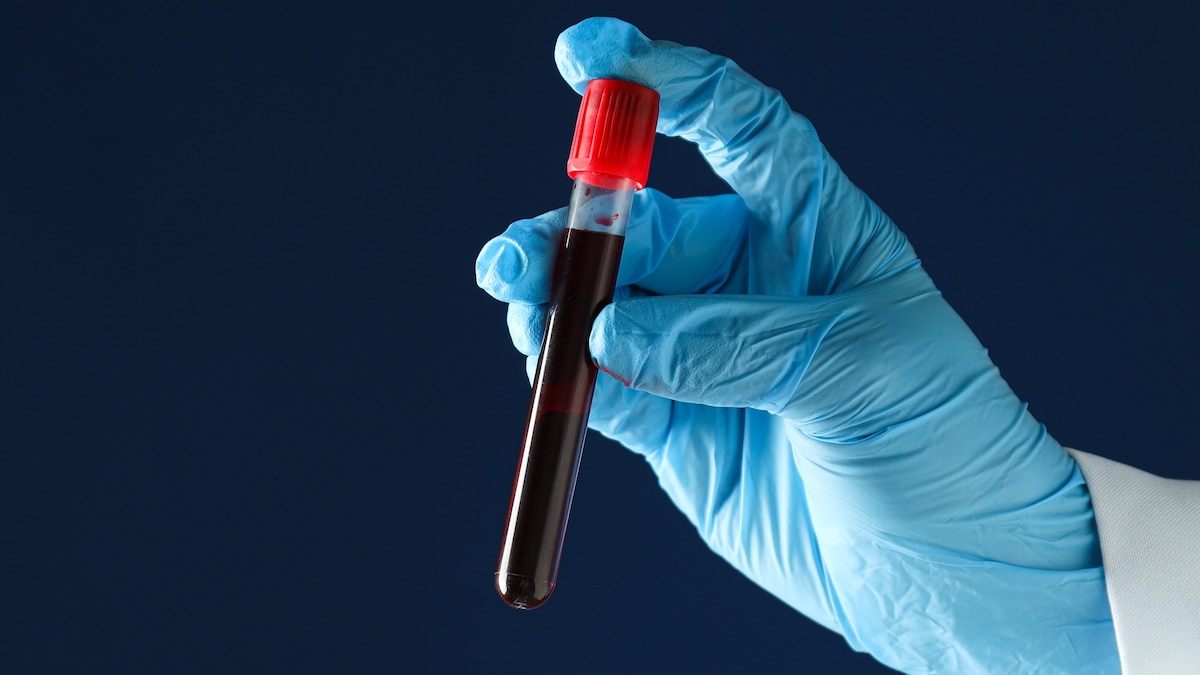Now Reading: A new blood test can tell if cancer has returned months before a scan
-
01
A new blood test can tell if cancer has returned months before a scan
A new blood test can tell if cancer has returned months before a scan

When Jennifer Feenstra was diagnosed with advanced, aggressive lung cancer five years ago, she didn’t waste time fretting about how she, a non-smoking fitness buff, could have gotten the disease. Instead, the 59-year-old retired graphic designer from Stamford, Connecticut, was determined to throw everything at it.
After surgeons at the Yale Cancer Center removed part of her right lung, she endured four rounds of grueling chemotherapy followed by three years of additional medicine. Throughout, she’s been regularly monitored with computerized tomography (CT), which thankfully has shown no trace of recurrence—the term for when cancers come back after treatment. Today, she’s in remission, but knows it would take a while for a returning tumor to show up on a scan.
Yet the building blocks for cancerous tumors appear in the body much earlier than imaging can detect them. That’s why doctors are excited about a newer type of surveillance that can reveal cancer-cell recurrence at its minute stages.
Blood tests looking for cancer markers have been around for decades, but the latest generation of tests hunt for tiny fragments of an individual cancer’s DNA in a person’s blood. These tumor-informed tests are a striking advance in what’s known as circulating tumor DNA (ctDNA) analysis, and researchers at Yale and other cancer centers are already seeing intriguing results.
(What we’re learning from lung cancer patients who never smoked.)
In a study published in Nature Medicine in March, one of these tests diagnosed recurrence in lung cancer patients a median of five months before something appeared on a scan, much earlier than it is usually found. If the test were offered to her, “I would want to do it,” Feenstra says. “It would be another tool to potentially help my outcome.”
When it comes to this technology, though, potentially is the operative word. But it’s one getting lost as some doctors rush to embrace tests already on the market.
Global sales for the category known colloquially as liquid biopsies (including versions that screen healthy people for early signs of cancer) could reach $20 billion in the next few years, according to health research firm iHealthcareAnalyst. The biggest sellers target lung, breast, colorectal, gastric, and prostate cancers, the analysis notes, “driven by the millions of newly diagnosed cancer patients worldwide.”
The goal is to personalize cancer treatment for individual patients. “The technology is exciting because we can monitor outcomes in real time and determine who needs more or less treatment,” says Roy Herbst, deputy director of the Yale Cancer Center and lead author of the Nature Medicine study. Should the method detect cancer in someone like Feenstra during the time they’re on post-chemo medication, for example, doctors might prescribe the drug for longer. Or patients might switch to a different medicine they haven’t developed a tolerance to, Herbst says.
Because clinical laboratories administer these tumor DNA tests, they don’t go through the same approval process as drugstore tests. But outside of clinical trials, the test should not currently be offered to patients, Herbst and other researchers say. “We need more data, especially because we don’t know all the harms,” he says.
Also yet to be determined: whether the test truly prolongs a patient’s life.
Early tumor DNA detection is linked to poor prognosis
The technology of these personalized ctDNA tests stems from the knowledge that cancerous tumors develop genetic mutations as they grow. Some are common across a specific cancer type, such as the epidermal growth factor receptor (EGFR) changes found in many non-small cell lung cancers (which earlier generations of ctDNA tests look for). Others are unique to each person’s individual tumor, which continues to change as it grows. All of these mutations can be detected because some of a tumor’s DNA leaks into the blood.
The testing process starts after a cancer surgeon removes the tumor, when a piece is sent to a specialized laboratory to sequence its genome. The lab also sequences the person’s own genes. Comparing the two sequences reveals mutations distinct to the tumor. That allows technicians to create an individualized assay targeting traces of the cancer’s mutational fingerprint in the person’s blood. Depending on the lab producing the test, anywhere from a few dozen to more than a thousand mutations are targeted.
You May Also Like
“The tests look DNA-strand by DNA-strand for which are mutated and which are not,” says Jonathan Goldman, director of clinical trials in thoracic oncology at University of California, Los Angeles, and a coauthor of the Nature Medicine research. Because the tests are created for each specific tumor, “if the blood test catches a mutated copy, it’s pretty dependable.” (While false positives are unlikely, guidance in 2024 from the U.S. Food and Drug Administration notes that “assessments can vary among laboratories and technologies used to detect ctDNA which can result in discrepant results.”)
Studies in recent years confirm that patients generally have a worse prognosis when these types of tests flag early, microscopic recurrence. Breast cancer patients testing positive following treatment with the currently available NeXT ctDNA test, for example, had shorter overall survival compared with negative testers, according to a study of 78 patients published in February. Results were similar when the same test was given to 171 early lung cancer patients.
Getting a positive result “is a bad sign,” because cancers that return quickly tend to be aggressive, says H. Gilbert Welch, a cancer researcher at Brigham and Women’s Hospital in Boston.
(Why cancer rates are rising in young women—and what to do about it.)
Does early diagnosis save lives?
One of the most promising prospects is that early testing could spare some patients treatments they don’t need. Some 450 people with stage II colon cancer were randomized to tumor-informed ctDNA analysis soon after surgery to help determine whether they needed chemotherapy, or to traditional care with treatment decisions based on symptoms and pathology. Negative testers avoided the chemo without more cancer recurrence or death, according to a study published in the New England Journal of Medicine in 2022.
“The only people who get adjuvant chemotherapy are those that have some evidence of minimal residual disease,” Welch says of the study. “And everybody else gets to be done.”
The period after surgery when next-step treatment choices are made, known as the landmark window, is currently a confusing time, says Richard Chen, chief medical officer of Personalis, in Freemont, California, which makes the NeXT test. Doctors tell him, “If we had a test that could tell us right after surgery which patients were at most risk or least at risk for recurrence, that that could help drive decision making about whether to avoid therapy or alternatively double down,” he says.
But it is not yet clear whether once a person is in remission but has microscopic evidence of disease, earlier treatment improves their survival. Studies of cancer surveillance using imaging like CT scans and x-rays suggest it may not.
Half of the dozen high-quality imaging surveillance clinical trials for cancers of the breast, colon, lung, and connective tissue show that people who undergo periodic imaging surveillance live longer, but half show they do not. It’s “essentially a coin flip,” Welch concluded in an essay in New England Journal of Medicine in April. That’s why the American Cancer Society does not recommend post-treatment imaging surveillance for most patients with treated early-stage breast cancer.
(When should you get screened for breast cancer—and how often?)
It’s possible that this ctDNA analysis will be different, since it detects recurrence much earlier than any current test. But “treatments may turn out to work just as well if people wait until symptoms appear to indicate a cancer’s recurrence,” Welch says. Only randomized clinical trials can answer this important question.
A clearer understanding of the benefits of post-cancer personalized ctDNA analysis will help patients and physicians weigh the harms. The latter include the expense of the tests (a colon cancer analysis costs $3500 per patient, according to one estimate), not to mention the emotional trauma of learning cancer has returned during a time someone might otherwise be happily going about their life.
The extra or earlier rounds of chemotherapy that come with a positive test can also be damaging. “It’s not insignificant to give a patient who’s asymptomatic a potentially toxic therapy,” says Anne Knisely, a gynecologic oncology researcher at the University of Texas MD Anderson Cancer Center.
Knisely’s ongoing study of personalized ctDNA following treatment in women with ovarian cancer confirmed that positive results predict a poor prognosis, she reported at the Society of Gynecologic Oncology meeting in 2024. Knisely hopes that individualizing treatment based on the test’s results may eventually improve ovarian cancer’s abysmal survival rate or at least spare patients from grueling chemo that doesn’t help them. But both are open questions.
“We need to distinguish between data and useful knowledge,” Welch says. “Before we spend millions—or billions—of dollars regularly checking ctDNA activity, we ought to know whether it really helps people live longer and better.”























